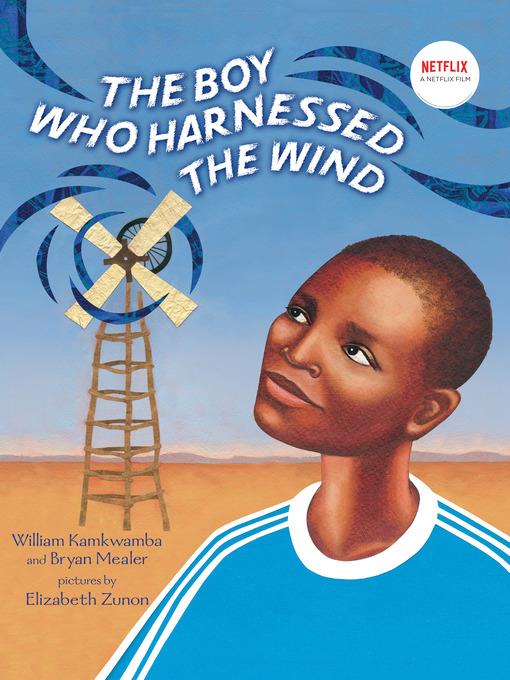
The Boy Who Harnessed the Wind
فرمت کتاب
ebook
تاریخ انتشار
2012
Lexile Score
850
Reading Level
4-5
ATOS
5.3
Interest Level
K-3(LG)
نویسنده
Elizabeth Zunonشابک
9781101578636
کتاب های مرتبط
- اطلاعات
- نقد و بررسی
- دیدگاه کاربران
نقد و بررسی

diamondkid - This book was really good. The story is about when a terrible drought struck William Kamkwamba's tiny village in Malawi, his family lost all of the season's crops, leaving them with nothing to eat and nothing to sell. William began to explore science books in his village library, looking for a solution. There, he came up with the idea that would change his family's life forever: he could build a windmill. Made out of scrap metal and old bicycle parts, William's windmill brought electricity to his home and helped his family pump the water they needed to farm the land. After you saw this comment I encourage you to read The Boy Who Harnessed the Wind: Young Readers Edition. Really Good Book!!! :)

December 5, 2011
Zunon’s (My Hands Sing the Blues) oil paint and cut-paper collages amplify the entwined themes of science and magic in this adaptation of the authors’ 2009 adult book. Kamkwamba was born in Malawi in 1987, and when he was 14, drought was ravaging his country. Forced to leave school to save money, Kamkwamba studied science books at the library, learning about windmills—and their potential. “He closed his eyes and saw a windmill outside his home, pulling electricity from the breeze and bringing light to the dark valley.” Gathering materials from the junkyard, he assembles a windmill that creates “electric wind” and even lights a light bulb. Tradition and “tales of magic” combine with the promise of technology in this inspiring story of curiosity and ingenuity. Zunon’s artwork combines naturalistic and more whimsical elements; the African sun beats down on Zunon’s villagers, ribbony “ghost dancers” encircle Kamkwamba’s bed while he sleeps, and blue cut-paper swirls sweep toward the windmill. While the narrative simplifies Kamkwamba’s creative process, an afterword provides additional detail for readers who share his mechanical inclinations. Ages 6–8. Agent: ICM. Illustrator’s agent: Painted Words.

December 1, 2011
The true story of a Malawian teenager who leveraged need and library research into a windmill constructed from found materials. Forced by drought and famine to drop out of school, William dreams of "building things and taking them apart." Inspired by science books in an American-built library near his village, his dreams turn to creating "electric wind." Despite the doubts of others he begins--assembling discarded bicycle parts and other junk into a rickety tower, triumphantly powering an electric light and going on to dream of windmill-driven wells to water the land. Kamkwamba tells this version (another, for adult readers, was published with the same title in 2009) of his tale of inspiration meeting perspiration in terse, stately third person: "He closed his eyes and saw a windmill outside his home, pulling electricity from the breeze and bringing light to the dark valley." Zunon illustrates it handsomely, with contrasting cut-paper-collage details arranged on brown figures, and broad, sere landscapes painted in visibly textured oils. A plainspoken but inspiring tale of homespun ingenuity. (afterword) (Picture book/biography. 7-9)
(COPYRIGHT (2011) KIRKUS REVIEWS/NIELSEN BUSINESS MEDIA, INC. ALL RIGHTS RESERVED.)

January 1, 2012
K-Gr 3-Based on the best seller of the same title, this picture-book biography chronicles Kamkwamba's teen years in a Malawian village. As he tills the soil, his mind teems with a mix of mechanical questions and the magical stories relayed by his elders. When a drought destroys the crops, his education fund dries up as well. Kamkwamba seeks refuge in the American-built library, where, dictionary in hand, he decodes the function of a windmill that has captured his interest. Despite the murmurings of incredulous villagers, the young man assembles junkyard scraps to build "electric wind." The third-person descriptions and dialogue are flavored with African phrases. Zunon's compositions, rendered in cut paper and oils, create a variety of moods. Colorfully garbed ghost dancers populate the boy's dreams, while crumpled tan rice paper, arranged to depict a high horizon line just beneath a blazing sun, forms a parched landscape, overwhelming in scale. Swirls of patterned blue and green paper portray the wind that propels the blades of his creation. While an extensive author's note explains that it took several years to achieve the ability to irrigate, the lack of clear visuals to show how wind becomes electricity (and ultimately pumps water) may frustrate young children. That caveat aside, this is a dynamic portrait of a young person whose connection to the land, concern for his community, and drive to solve problems offer an inspiring model. It would pair well with one of the recent titles about Wangari Maathai.-Wendy Lukehart, Washington DC Public Library
Copyright 2012 School Library Journal, LLC Used with permission.

February 15, 2012
Grades 1-3 In his drought-stricken village in Malawi, Kamkwamba, 14, had to drop out of school, but he read about windmills in the library, and with scraps from the trashincluding a tractor fan, a shock absorber, the frame of a broken bicycle, rusted bottle caps, and plastic pipeshe buildt a windmill tower that brought electricity to his village. Based on the adult best-selling version of a true story, this picture book in accessible free verse will draw kids who love to construct their own engineering gadgets. Especially appealing is the triumph of the young boy who bottled, banged, and tinkered and saved his grown-up world. Zunon's double-page artwork, a blend of oil paintings and cut paper, shows the drought-stricken countryside and then the trash pieces the boy collects and recycles into a machine that makes energy for his community. The long afterword fills in more about the severe drought that brought famine and killed more than 10,000 people and about Kamkwamba's engineering studies now.(Reprinted with permission of Booklist, copyright 2012, American Library Association.)

























دیدگاه کاربران